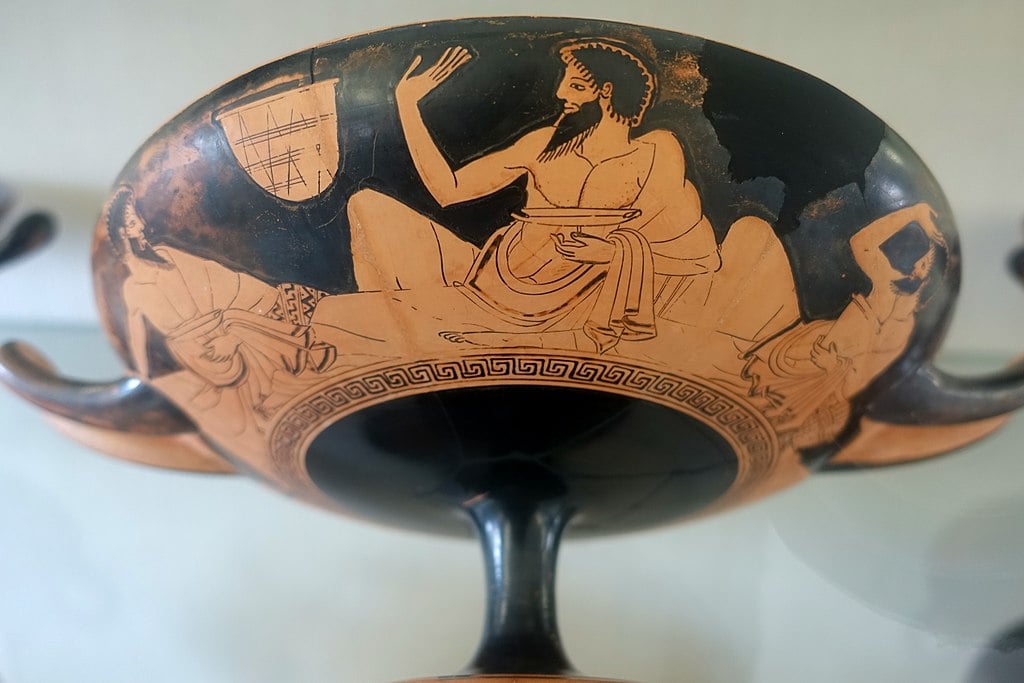
The symposium was one of the most important aspects of ancient Greek culture, as it served as an essential setting for discussions, revelry, and debates among some of the most prominent figures in Greek antiquity.
Symposium, or “συμπόσιον” in Greek, comes from the words “σύν” and “πίνω,” or “drink together” in other words. It describes a banquet amongst many guests, all men, that usually occurred after a meal had been served.
During the symposium, men of the aristocracy drank wine and enjoyed music, performances, dancing, and other forms of entertainment.
Serious debates and discussion regarding matters of public interest, politics, art, culture, and philosophy took place at symposia.
Ancient Greek Symposium: eat, drink, philosophize
Ancient texts such as Plato’s Symposium and Xenophon’s Symposium, both of which were written in the 4th century BC, provide a look into the ritualized drinking party.
Symposia were held in private homes in a special room called an “Andron.” The room was usually situated at the front of the house, and those participating in the event would recline on couches that lined the room.
Ancient Greeks would also recline as they ate. The habit of reclining to dine in ancient Greece began at least as early as the 7th century B.C. and was later picked up by the Romans.
Strangely, Greeks are always pictured lying on their left side—never their right.
The reason for this tradition is not entirely clear, but historians and classicists have debated the topic for decades.
Some argue that lying on this particular side leaves the right hand free to grasp vessels used to eat and drink; yet, there are examples of Greeks in ancient art reclining on their left side and still using their left hands to eat and drink.
According to scholars, it would be rare for an andron to house more than seven to nine couches, which limited the number of total participants to under thirty.
The special room and the couches found within it, along with the cups used to drink wine, were usually finely decorated and served as a show of one’s wealth and fine taste.
Entertainment could include musicians playing the flute and other ancient instruments, poetry recitals, dances, and even acrobats.
There was also an erotic element to many symposia, as evidenced by the large number of vases and artworks depicting sexual scenes at the ancient drinking parties.
Sex and drinking games
Although only men were allowed to participate in the symposium itself, women were permitted to enter the andron as entertainers or courtesans.
In ancient Greece, courtesans, or “hetairai,” were not simply escorts. They were seen as educated, interesting, and intelligent so that they could have engaging discussions with their clients.
A number of particularly alluring and intelligent hetairai became famous and garnered significant influence in ancient Greece, most notably Phryne.
Hetairai attended symposia to provide not just sex but also to perform music and even engage in debates and discussions with the participants. Ancient vases also depict sexual activity between men at symposia.
While the sexual and more intellectual aspects of the symposium may be well known, many may be surprised to learn that the ancient Greeks also played drinking games.
Ancient Greeks are famous for their love of wine, but the wine they drank does not resemble the alcoholic beverage we consume today.
In antiquity, Greeks drank diluted wine that was mixed with water in a container called a krater.
Drinking undiluted wine was something associated with non-Greeks, who were considered barbarians and was thought to cause unruly and unbecoming behavior.
For this reason, ancient Greeks drank diluted wine, which allowed them to maintain their composure and self control.
This diluted water-wine mix left dregs from the wine-making process at the bottom of drinkers’ vessels. A popular drinking game called “kottabos” involved throwing one’s dregs at the bottom of their cup onto the floor, with the hopes of spelling out the first letter of their lover’s name with the remnants, or of hitting a particular spot on the floor.
For this reason, most floors in the special rooms where symposia took place were waterproof.
See all the latest news from Greece and the world at Greekreporter.com. Contact our newsroom to report an update or send your story, photos and videos. Follow GR on Google News and subscribe here to our daily email!



